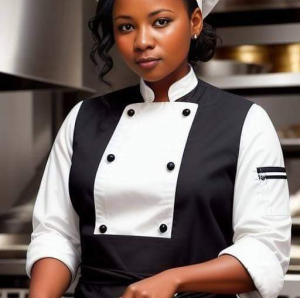FOOD AND BEVERAGE SERVICE
Completion requirements
3. Food and beverage service areas and equipment
3.3. Hotplate
The hotplate or pass is the meeting point between the service staff and the food preparation
staff. Active co-operation and a good relationship between the members of staff of these two
areas help to ensure that the customer receives an efficient and quick service of their meal.
The hotplate itself should be stocked with all the crockery necessary for the service of a meal.
This may include some or all of the following items:
l soup plates
l fish plates
l joint plates
l sweet plates
l consommé cups
l platters
l soup cups.
The food flats and serving dishes required for service are often placed on the top of the hotplate
to warm through and used as required. The hotplate is usually gas or electrically operated and
should be lit or switched on well in advance of the service to ensure all the necessary crockery
and silver is sufficiently heated before the service commences.

Aboyeur or barker
The aboyeur, or barker, is in charge, and controls the hotplate (or pass) during the service
period. As an aid to the food service staff the aboyeur would control the ‘off board’, which
tells the waiter immediately of any menu item that is not available (off). It should be sited in a
prominent position for all to see.
The aboyeur will initially receive the food check from the waiter. Written food orders must
be legible to the aboyeur so that there is no delay in calling up a particular dish. The aboyeur
checks that none of the dishes ordered are off the menu. Then the order from the various
‘corners’ (or ‘parties’ or ‘sections’) of the kitchen is called up, as each particular dish is required.
If a dish required has to be prepared and cooked to order, then it is important that the aboyeur
orders this to be done before the waiter comes to the hotplate to collect it. This ensures there
will be no major delay for the waiter who is going to serve the dish or for the customer who is
waiting for the next course to be served. When a food check is finished with it is placed into a
control box. This box is often kept locked and can only be opened by a member of staff from
the control department who, for control purposes, marries the copy of the food check from the
kitchen with the copy the cashier has and the duplicate copy of the bill.
With the modern use of an EPOS (electronic point of sale) system the electronic order can
be sent directly from the restaurant to each section of the kitchen and the aboyeur is the
co-ordinator for the dishes to arrive on the pass at the same time, checking for quality before
releasing the plate to the waiting staff. The control department then uses the EPOS information
to control sales and revenue. (For an example of a radio-controlled electronic system for order
taking and communication, see Section 6.3, p.215 and Figure 6.20, p.215.)
Hotplate language and terminology
To ensure there is no delay in any food dish reaching the hotplate, the aboyeur should call it
up, allowing time for preparation, cooking and presentation. Various special kitchen terms are
used to warn the food preparation staff working in various corners to get ready certain dishes.
Because of a multi-national work force, many establishments now use one single specified
language within a kitchen. This is often the language of the country, such as English in the UK.
All members of staff need to know the system for their own establishment.
Examples of traditional kitchen terms are:
l Le service va commencer: general warning to kitchen that service is about to commence.
l Ça marche trois couverts: indication to the kitchen of the number of covers on the table,
in this case three covers.
l Poissonnier, faites marcher trois soles Véronique: example of fish section informed of the
order required, in this case three sole Véronique.
l Poissonnier, envoyez les trois soles Véronique: when the order is required at the hotplate
by the waiter, the aboyeur calls it up. In this example it is the fish section being told to bring
the order for the three sole Véronique.
l Oui: the reply given by the chef de partie (section chef) to the order called out by the aboyeur.
l Bien soigné: the term called out by the aboyeur before the actual order when an extra
special order is required.
l Dépêchez-vous: the words used to hurry up an order.
l Arrêtez: the term used to cancel an order.
l Foods requiring special degrees of cooking are given the following terms:
l Omelette baveuse: soft inside.
l Steak grillé:
– bleu: (rare) surfaces well browned, inside raw
– saignant: underdone
– à point: medium
– bien cuit: cooked right through, well done.
Whatever system is used all food service staff should be familiar with the specific terms being
used in the production area in order to appreciate exactly what is going on at the hotplate and
in the food production areas, to ensure quick and efficient service.
